What Is the Fundamental Stylistic Difference Between Paleolithic Art and Neolithic Art?
Northeolithic artwork is part of Prehistoric art, non but did it serve functional purposes, equally is then characteristic of Prehistoric fine art, but it served aesthetic purposes too. Neolithic fine art is our visual record of the beginnings of civilisation. This article volition explore the question, "what is Neolithic fine art?"
Table of Contents
- one The New Stone Historic period: When Was the Neolithic Age?
- 1.1 The Three-Age System
- i.2 The Neolithic Revolution
- two What Is Neolithic Art?
- 2.1 Characteristics of Neolithic Artwork
- three Neolithic Artwork
- 3.1 Çatalhöyük
- three.two Jericho
- 3.3 Neolithic Megalithic Structures and Artwork
- three.iv Neolithic Pottery and Ceramics
- iv From the New Stone Age to the Gimmicky Age
- five Frequently Asked Questions
- 5.ane When Was the Neolithic Menses?
- v.two What Is Neolithic Art?
- five.iii What Are the Characteristics of Neolithic Fine art?
The New Stone Age: When Was the Neolithic Age?
Earlier we look at Neolithic fine art, a brief contextual background of the Neolithic period volition give us more understanding. The Neolithic age was the last part of the Stone Historic period, it was also referred to equally the "New Stone Age". Information technology occurred, approximately, around 10 000 BCE to 3000 BCE.
The word "Neolithic" originates from the Greek words néos meaning "new" and líthos meaning "stone". The English scientist John Lubbock introduced the term "Neolithic" and "Palaeolithic" in the 1870s, the latter of which was the earlier office of the Stone Historic period, also referred to as the "Quondam Rock Age".
In-between the Neolithic and Palaeolithic eras was the Mesolithic Rock Age, meaning "Middle" Stone Age.
The 3-Age System
The Stone Historic period falls into the broader categorization of prehistoric times, so allow us briefly zoom out and see where we are. The Three-Age System, started in the 19th Century, was utilized every bit an archaeological dating tool to categorize prehistory into iii respective periods, namely, the Stone Age (c. two.half-dozen million years ago to 3000 BCE), the Statuary Historic period (c. 3000 BCE to 1300 BCE), and the Fe Age (1300 BCE to 900 BCE).
This categorization made information technology easier for not simply archaeologists and scholars, but anyone who seeks to understand the history and development of man. Although in that location were other scholars that introduced a divisionary system for prehistory, the Danish man Christian Jürgensen Thomsen, the Director of the Regal Museum of Nordic Antiquities, refined this method of classification.
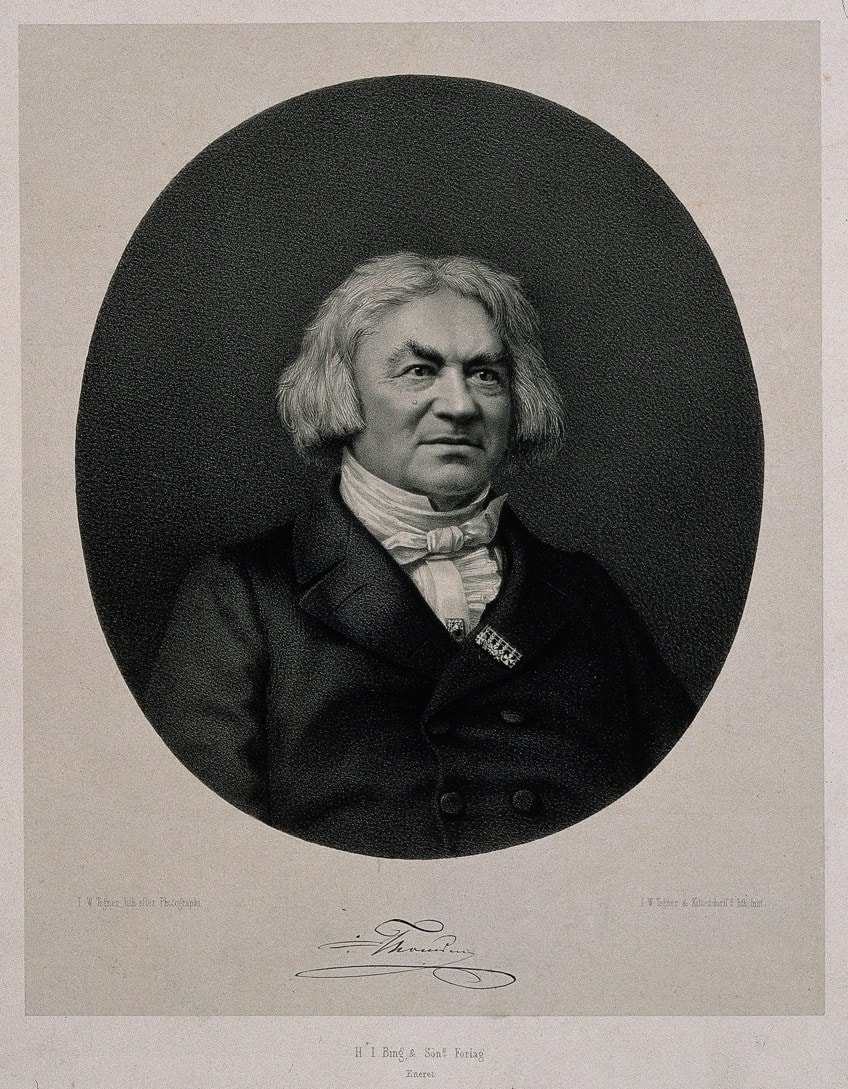 Portrait of Christian Jürgensen Thomsen (1788-1865);See page for author, CC BY 2.0, via Wikimedia Commons
Portrait of Christian Jürgensen Thomsen (1788-1865);See page for author, CC BY 2.0, via Wikimedia Commons
He outlined this system in 1837 in one of his essays, titled, Kortfattet Udsigt over Mindesmærker og Oldsager fra Nordens Fortid (1837) ("Brief Outlook on Monuments and Antiquities from the Nordic Past"). This essay was function of a collection of volumes published by the Danish Royal Society for Aboriginal Nordic Manuscripts, this was titled, Ledetraad til Nordisk Oldkyndighed (1836) ("Guideline to Scandinavian Antiquity").
Thomsen'southward method was significant because he categorized different materials from prehistoric times, namely, rock, bronze, and iron.
Additionally, these dissimilar periods existed in different parts of the world. For example, some of the primary Neolithic regions were Mesopotamia, the Levant, N Africa, Asia, and Western and Northern Europe, among others. The time periods also ranged between regions.
The Neolithic Revolution
The Neolithic menstruum marked the beginnings of changes in civilization, this has been referred to as the Neolithic Revolution. This term was introduced past the Australian archaeologist, Vere Gordon Childe in the early 1900s. Childe'south usage of the term "revolution" could have possibly come from the tenets of Marxism, which influenced him.
It is important to notation that most of the changes during these prehistoric periods occurred gradually – it was not an overnight occurrence. The nomadic lifestyle was still prominent and with steady progression, farming increased, which led to settlements. Childe's concept of a "revolution" as well received critique from various archaeologists because it may have been "misleading".
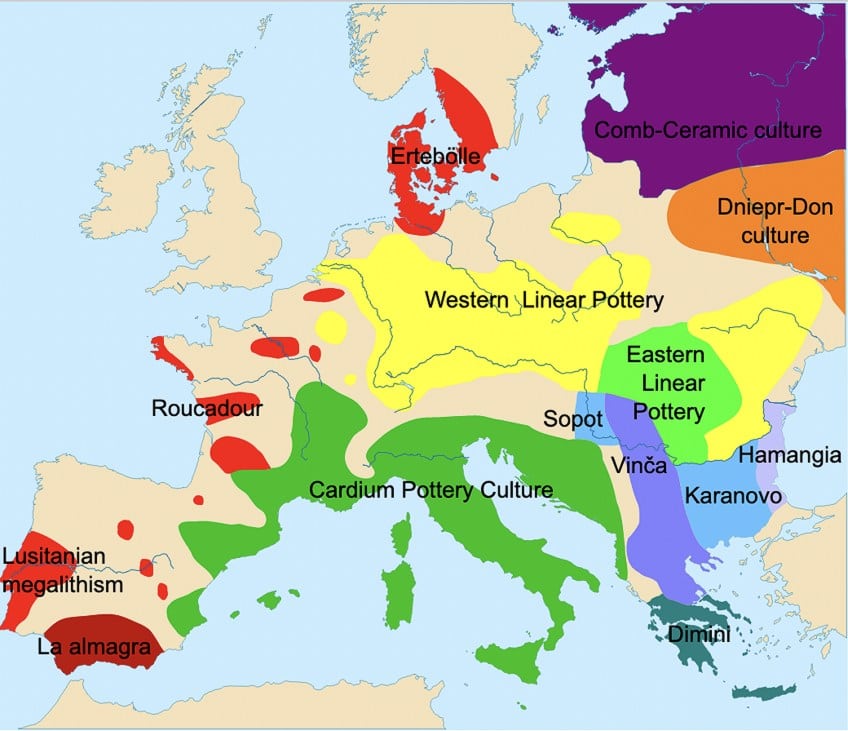 A short animation of the chronology of the introduction of agriculture in Europe;Wikirictor, CC BY-SA iv.0, via Wikimedia Eatables
A short animation of the chronology of the introduction of agriculture in Europe;Wikirictor, CC BY-SA iv.0, via Wikimedia Eatables
From the hunter-gatherer manner of living in that location were new developments in farming and agronomical modes of living. During the Palaeolithic period, people utilized rock and bone tools, just these were basic in their form. Artwork existed during this period, just it was also rudimentary, made from natural materials and pigments.
The Mesolithic period slowly became more developed with polished tools besides as the beginnings of agriculture and settlements. This then became the Neolithic period, where settlements were permanent, people farmed, grew grains, domesticated animals, and various habitation-based functions similar weaving, pottery, and sewing. This certainly was a "revolutionary" type of period in human being evolution considering it set the foundations for humans to settle and live in more than permanent environments.
This type of living, compared to the nomadic lifestyle, inevitably changed human behaviors and in plough, it affected all areas of life, including fine art and what it was made for.
What Is Neolithic Art?
As we discussed above, the Neolithic period savage somewhere betwixt ten 000 BCE to 3000 BCE. It marked the beginning of numerous new developments in social and cultural life. In clarifying the Neolithic art definition, we will hash out various related characteristics below.
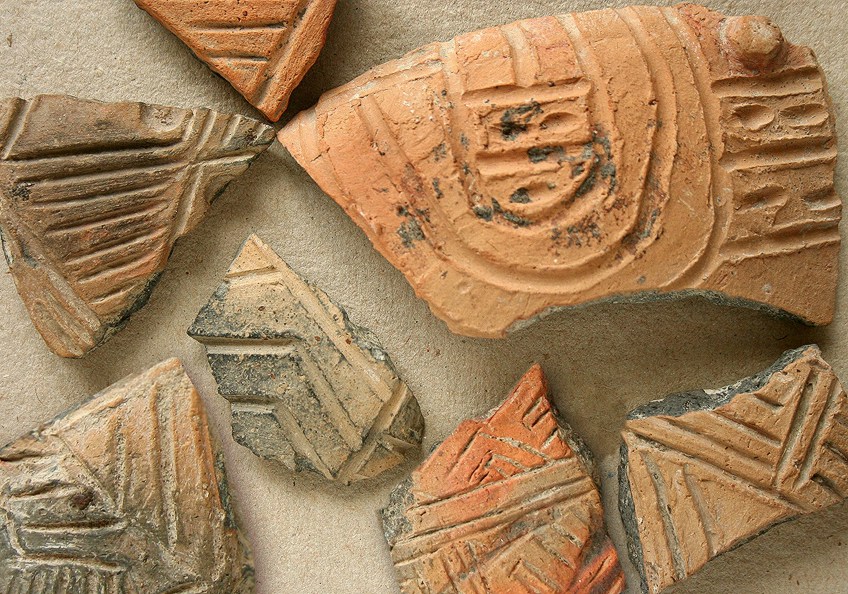 Geometrical scratched motive almost Hodmezovasarhely, Hungary, Neolithic period;Takkk, CC By-SA 3.0, via Wikimedia Commons
Geometrical scratched motive almost Hodmezovasarhely, Hungary, Neolithic period;Takkk, CC By-SA 3.0, via Wikimedia Commons
Characteristics of Neolithic Artwork
The characteristics we outline for Neolithic fine art are quite different from the type of characteristics we outline for art movements like the Renaissance. Neolithic art, first and foremost, served several functions, either related to food, farming, ritual, ornamentation, or any other purpose related to Neolithic living.
Furthermore, Neolithic art was not a separate attribute of the various Neolithic cultures, then nosotros will as well look at cultural characteristics, which inform the artwork.
The major changes that took identify during this time were notably the increased security in terms of safety and food. With this came an increase in population and people settled in communion or "small tribes". This likewise gave people the sense of place and territory, which inevitably increased the way they treated their environment, for example, living spaces, tools, objects, and each other.
 Map of the unlike cultures and settlements of the European Centre Neolithic period; !Original: west:Sugaar (talk | contribs);due west:Clarifer (talk | contribs)Vector: Joostik, CC By-SA 3.0, via Wikimedia Commons
Map of the unlike cultures and settlements of the European Centre Neolithic period; !Original: west:Sugaar (talk | contribs);due west:Clarifer (talk | contribs)Vector: Joostik, CC By-SA 3.0, via Wikimedia Commons
This follows on from how people treated one some other, there was an increase in hierarchical structures. Food was as well normally maintained and stored on a more communal level instead of individually in households. Furthermore, there were also areas for rituals, which were evidently tied to the veneration of crops and climate changes.
There was a focus on the feminine and masculine qualities, and we will notice this in the Neolithic sculpture of female figurines throughout these periods.
Cults and shamanism were also a role of cultures and certain animals held more meaning than others. The realm of organized religion and ritual during prehistoric times is complex, and it is important to note the vastness of it throughout the regions and the importance placed on different deities and conceptions of the divine.
Neolithic Artwork
Neolithic artwork consists mostly of pottery, terracotta sculptures, statuettes, various smaller pieces that were utilized as adornments, Neolithic drawings similar engravings and wall paintings, pictograms, and nearly notably megalithic structures – call back Stonehenge (nosotros will get to that). Neolithic sculpture was likewise made through new techniques like sculpting it from clay and blistering it instead of just strictly through carving.
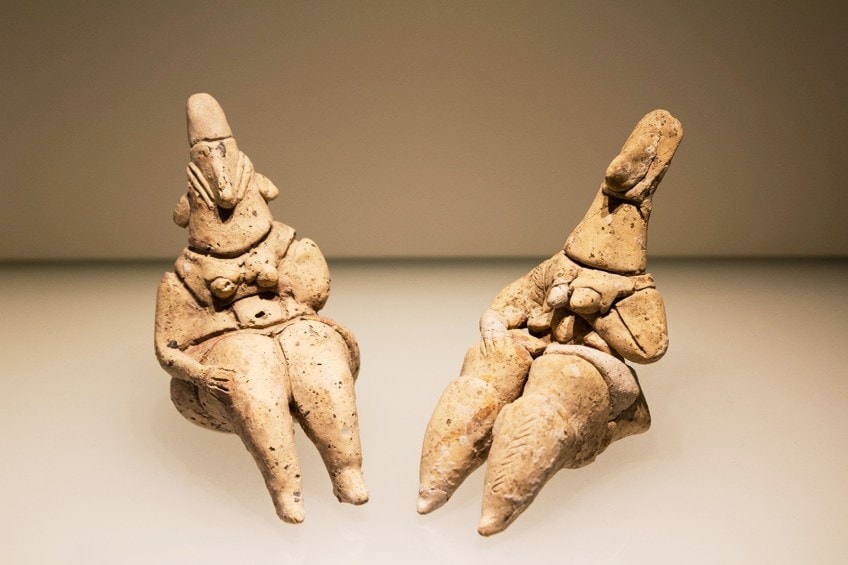 Neolithic Yarmoukian civilisation figurines at the Israel Museum in Jerusalem;Oren Rozen, CC By-SA iv.0, via Wikimedia Commons
Neolithic Yarmoukian civilisation figurines at the Israel Museum in Jerusalem;Oren Rozen, CC By-SA iv.0, via Wikimedia Commons
Beneath, we talk over some of the prominent creative pieces, from pottery, skulls, to megalithic structures. We volition also hash out of import archaeological sites where extensive collections of artworks were institute, giving us a visual indication of the role art played in the Neolithic communities.
Bear in mind that while this only touches on a select few examples of Neolithic artwork, there are significant numbers of artwork excavated from this art flow.
Çatalhöyük
Çatalhöyük is too referred to as Çatal Höyük and is an archaeological site in Turkey not far from one of the major cities named Konya. The site was accounted a UNESCO Globe Heritage Site in 2012. It is a site filled with bear witness of non only hunter-gatherers but people who settled and lived in communities. It is reported that effectually 6000 to 8000 people inhabited these spaces thousands of years ago.
The site consists of various buildings made of mud bricks, these were congenital very closely next to one another, in fact, people moved around via the rooftops and entered their respective living spaces through holes or doors in the roof, some doors were likewise on the sides, past means of ladders or stairs.
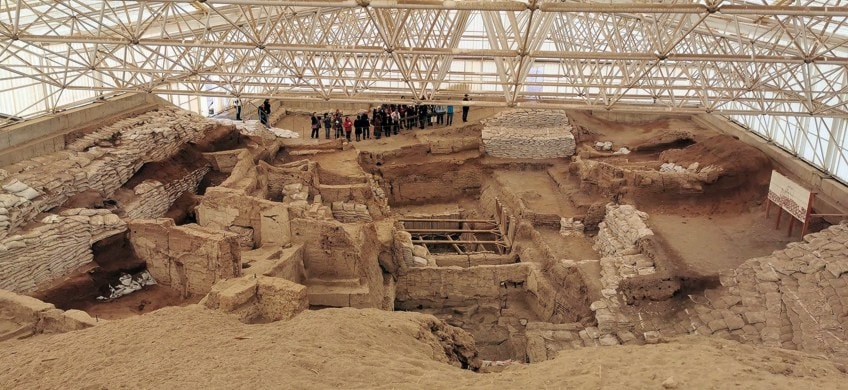 A very large Neolithic and Chalcolithic proto-urban center settlement in southern Anatolia, 7400 BC;Murat Özsoy 1958, CC BY-SA 4.0, via Wikimedia Commons
A very large Neolithic and Chalcolithic proto-urban center settlement in southern Anatolia, 7400 BC;Murat Özsoy 1958, CC BY-SA 4.0, via Wikimedia Commons
The walls inside the homes were usually plastered and rooms are reported to have been kept in tidy weather. Additionally, there were also up to ii rooms in a abode with an extra room that could have been utilized for storage purposes.
In that location has also been a diverse range of fine art discovered on this site, such every bit murals on walls inside and outside homes.
The subject matter for these murals was mostly geometric patterns and figural shapes. The figural shapes were often of animals with some human-like forms incorporated. An example of this is titled the Neolithic Wall Painting in Building eighty, Çatalhöyük, among many other such images.
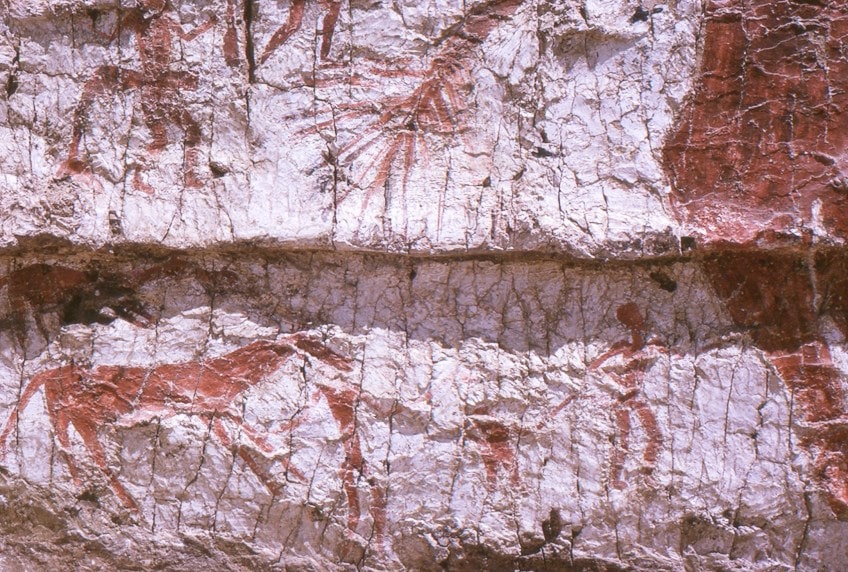 Particular of a Çatalhöyük mural showing the hind part of the aurochs, a deer, and hunters;Omar hoftun, CC Past-SA three.0, via Wikimedia Commons
Particular of a Çatalhöyük mural showing the hind part of the aurochs, a deer, and hunters;Omar hoftun, CC Past-SA three.0, via Wikimedia Commons
Some examples of this include vultures at a dead corpse and what appears as two cranes faced towards each other with a fox behind them. A characteristic stance or depiction of these figures has been described as "splayed" because we will often notice their heads non depicted or they would have no hands or feet.
Female clay figurines accept also been found on the site, for case, the popular Seated Woman of Çatalhöyük (c. 6000 BCE). This depicts a female person sitting between two feline figures, possibly 2 armrests with the heads of feline figures. Some sources advise she may too be sitting on the feline figures. It is not articulate what feline figures these are – it could possibly be leopards, lionesses, or panthers. The figurine is made of broiled clay and the correct armrest and caput take likewise been restored.
The figurine is currently housed at the Museum of Anatolian Civilizations, located in Ankara city, Turkey.
 Seated Adult female of Çatalhöyük, Museum of Anatolian Civilizations, Ankara, Turkey;User:Roweromaniak, CC BY-SA 2.five, via Wikimedia Commons
Seated Adult female of Çatalhöyük, Museum of Anatolian Civilizations, Ankara, Turkey;User:Roweromaniak, CC BY-SA 2.five, via Wikimedia Commons
These female figurines were popular forms of Neolithic and connected to female deities, notwithstanding, there has been debate over the importance of the female deities compared to male person deities, and sources also point out that both genders had equal continuing. Furthermore, there accept been around 2000 figurines excavated, predominantly consisting of animals.
The figurines were likewise found in different areas of homes, for example, some were plant in garbage pits, others in walls or floors. The purpose of these figurines could exist for skillful luck or to keep bad spirits at bay. The above-mentioned Seated Woman of Çatalhöyük was excavated from a grain bin.
The excavator, James Mellaart, suggested that her purpose was related to good harvests and the safety of food supplies.
Jericho
The Palestinian urban center, Jericho, is some other site where the Jericho Skull (9000 to 6000 BC) and other like skulls accept been found. What is unique about these skulls is that they are plastered human being skulls. Many were males, however, there were also females and children.
The skulls are believed to be continued to ritual and religious practices of burying the dead. When people died, they were buried under the floors and their skulls would often be plastered with shells placed in the remaining center sockets and sometimes human being features like hair would exist painted on them.
 A plastered skull from the ancient city of Jericho in Palestine 7000 BC;Mary Harrsch, CC BY two.0, via Wikimedia Commons
A plastered skull from the ancient city of Jericho in Palestine 7000 BC;Mary Harrsch, CC BY two.0, via Wikimedia Commons
There are other sources that propose the skulls were for the "practice of headhunting" in which instance they would be "trophies". Other suggestions indicate the skulls were to venerate the dead ancestors or to recall passed abroad loved ones by having an "paradigm" of them (in this example, their skull) plastered and decorated to announced more life-similar. The skulls were found at many other sites too, for example, Nahal Hemar, Tell Ramad, Beisamoun, Kfar Hahoresh, and others.
The verbal reason for these skulls is varied, merely from what the evidence suggests, these are early examples of what is believed to be portraiture in fine art.
Neolithic Megalithic Structures and Artwork
Equally nosotros move on from the Neolithic sites mentioned above, nosotros motility into what is probably i of the almost fascinating aspects of Neolithic art: Neolithic megaliths. These are found in numerous regions of the earth, and many are famously known in the regions of Europe like England and Ireland.
Stonehenge
Stonehenge (c. 2550 to 1600 BCE) is in England, on Salisbury Plain, Wiltshire. It is one of the biggest prehistoric structures constructed, consisting of numerous big stones arranged in a circle; there is an outer circle and inner circle. The outer circle consists of stones standing vertically each with a horizontal lintel rock. The stone is made from sarsen stone, which is a prevalent sandstone in England.
The stones stand around 13 feet alpine, mensurate to effectually 7 anxiety in width, and weigh over xx tons each.
Inside this ring are five sarsen trilithons (a trilithon is a structure consisting of two vertical stones next to the other with a horizontal rock on top of both), these appear in a horseshoe shape and weigh around 50 tons. We will also see diverse Bluestones inside the outer and inner circumvolve of sarsen stones.
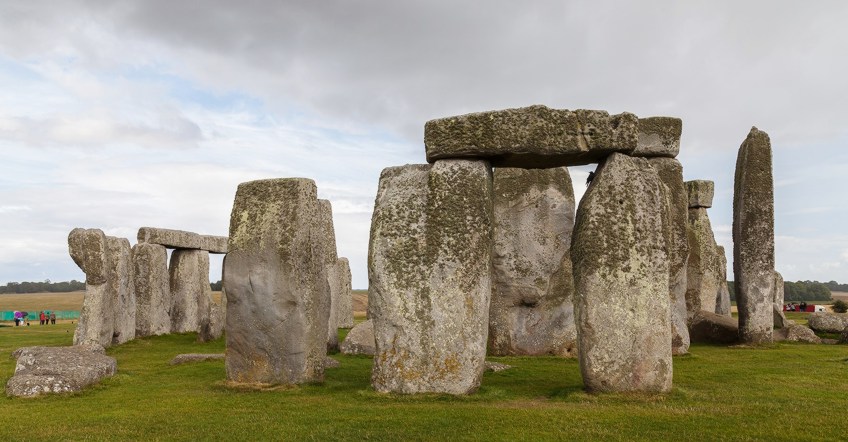 Stonehenge, Wiltshire, England; Diego Delso, CC By-SA 4.0, via Wikimedia Commons
Stonehenge, Wiltshire, England; Diego Delso, CC By-SA 4.0, via Wikimedia Commons
Stonehenge was reportedly built in 3 phases, although there is debate near the accuracy of when the phases took place. Phase 1 was around 3100 BCE, Phase 2 was around 3000 BCE, and Stage Three was around 2600 BCE, this was too the longest phase and lasted until around 2400 BCE.
This was a awe-inspiring undertaking and there is still a lot of debate most how this ancient structure was erected and by whom.
As to the function of Stonehenge, it possibly served religious and ceremonial purposes. Its orientation is towards the sunrise on the Summer Solstice, which gives a further indication for its purpose. It was declared a UNESCO World Heritage Site in 1986.
Avebury
In that location are also other stone monuments in the surrounding regions, for example, the Avebury monuments in Wiltshire, England. These are three stone circles located around the Avebury village. It is also office of a henge, a bank with a ditch, surrounding the stones. The outer circle measures 1088 anxiety and the inner circle of stone measures around 322 feet on the northern side and around 354 feet on the southern side.
 Avebury stones in the Southward Circle viewed from the south-east quadrant bank. From left to right, stones 103, 102, 101, and 105 are shown. The small concrete postal service marks the position of missing stone number 104. The tower of St James church building is in the background;JimChampion, CC BY-SA 3.0, via Wikimedia Commons
Avebury stones in the Southward Circle viewed from the south-east quadrant bank. From left to right, stones 103, 102, 101, and 105 are shown. The small concrete postal service marks the position of missing stone number 104. The tower of St James church building is in the background;JimChampion, CC BY-SA 3.0, via Wikimedia Commons
It was congenital approximately effectually 2850 BCE to 2200 BCE. This is part of the associated World Heritage Sites, of which Stonehenge is a part. There is also a wide debate near the construction of Avebury as well as its purpose. Many scholars and non-scholars take posed ideas as to this structure's purpose, some say information technology was nigh likely for ritual and ceremonial purposes.
Brú na Bóinne
Brú na Bóinne, meaning "Palace of the Boyne" or "Valley of the Boyne", is in the County Meath, Ireland. It is besides referred to as the Boyne Valley Tombs. Information technology includes the 3 major burial mounds or passage tombs, namely, Newgrange (c. 3300 to 2900), Knowth (c. 3200 BCE), and Dowth (between 3200 to 2900 BCE).
These are located about the River Boyne and are effectually twoscore to fifty kilometers north of the city of Dublin. The site was declared a UNESCO World Heritage site in 1993. The Brú na Bóinne complex is home to numerous Neolithic henges, stones, tomb chambers, mounds, and other structures related to ceremony and ritual.
An interesting fact about the Brú na Bóinne complex indicates that it was built before the Pyramids in Egypt.
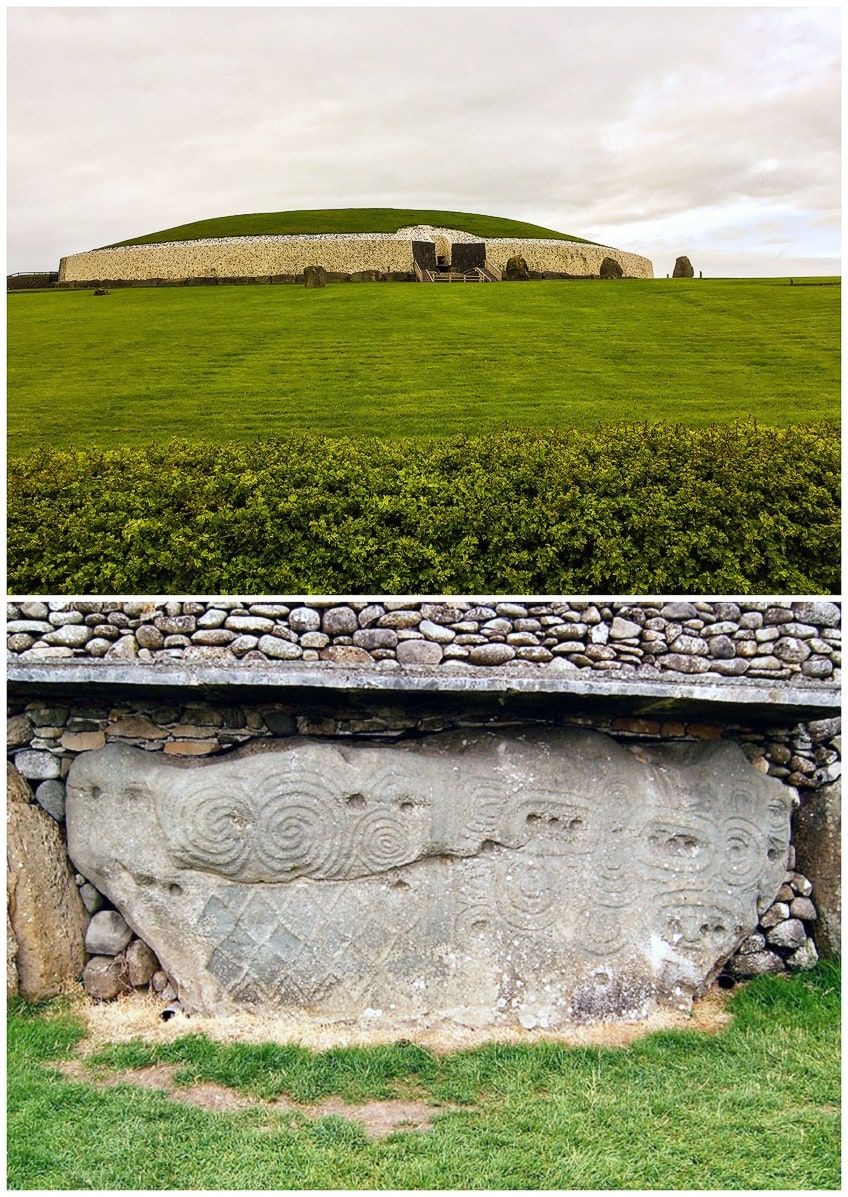 TOP: The Neolithic passage tomb of Brú na Bóinne in Newgrange; Dieglop, CC BY-SA 4.0, via Wikimedia Commons | BOTTOM: A detail of i of the Neolithic borderstones of Brú na Bóinne, Newgrange; Pasztilla (régi), CC BY-SA 3.0, via Wikimedia Commons
TOP: The Neolithic passage tomb of Brú na Bóinne in Newgrange; Dieglop, CC BY-SA 4.0, via Wikimedia Commons | BOTTOM: A detail of i of the Neolithic borderstones of Brú na Bóinne, Newgrange; Pasztilla (régi), CC BY-SA 3.0, via Wikimedia Commons
Nosotros will also find the extensive knowledge and application of astronomy, such every bit the Newgrange mound and its passage. The mound (measuring 249 feet wide, or beyond the structure, and 39 anxiety in height) was congenital with layers of rock and world with a passage leading around 60 feet into the key office inside the mountain. The passage inside the chamber is aligned when the sunday rises in the Winter Solstice. The chamber within is lit upward for an estimated fourth dimension of 17 minutes.
Another of import aspect of these mounds is their Neolithic rock art or rock engravings.
These are significant examples that tell us about the Neolithic period fine art in Republic of ireland. There are geometric motifs in distinct patterns, namely, spirals, circles, arc-like forms, chevrons, diverse lines similar parallel lines, lozenges, and radials.
The triple spiral or "triskele" shape is among one of the common shapes we see on Irish megaliths. There is broad debate amid scholars almost the purpose of these designs, some say they are symbolic while others say they are decorative.
Neolithic Pottery and Ceramics
There were four periods that categorized Neolithic pottery and ceramic production in the Middle East, in the Mesopotamia region. These were namely, the Hassuna period (c. 7000 to 6500 BCE), the Halaf menses (c. 6500 to 5500 BCE), the Ubaid period (c. 5500 to 4000 BCE), and the Uruk period (c. 4000 to 1300 BCE).
The Hassuna period was named after the archaeological site called Tell Hassuna in Iraq.
It was the site where the Neolithic Hassuna culture lived. The pottery from this site has been divided into three phases, namely, Hassuna Archaic, Hassuna Standard, and Samarran. The characteristics of pottery include flossy coloring with incised patterns.
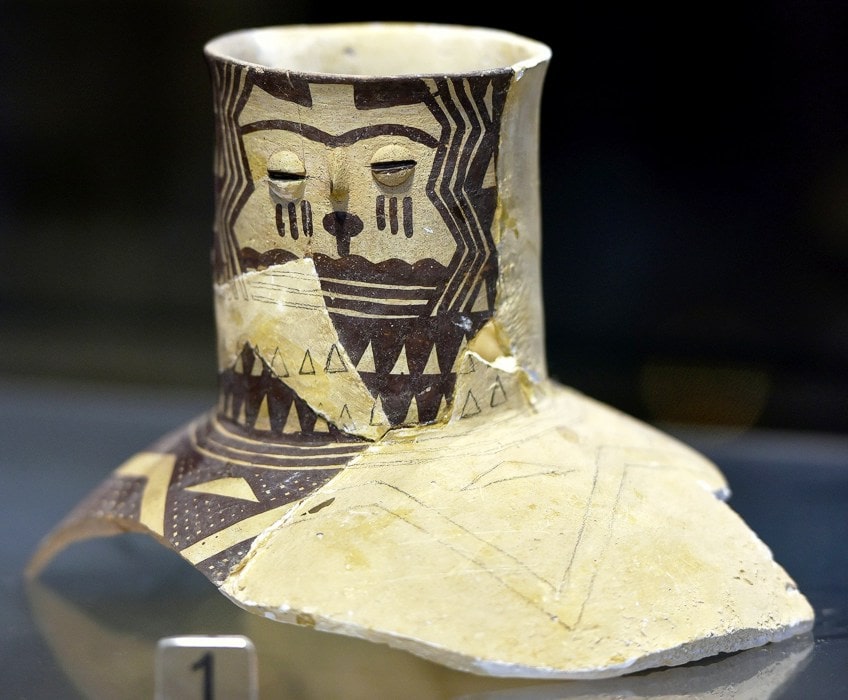 A pottery fragment showing the neck of a bottle-shaped jar painted with a woman's face. The eyes and nose were added. The overall depiction points to Samarra culture from Tell Hassuna, 5000 BCE;Osama Shukir Muhammed Amin FRCP(Glasg), CC Past-SA 4.0, via Wikimedia Eatables
A pottery fragment showing the neck of a bottle-shaped jar painted with a woman's face. The eyes and nose were added. The overall depiction points to Samarra culture from Tell Hassuna, 5000 BCE;Osama Shukir Muhammed Amin FRCP(Glasg), CC Past-SA 4.0, via Wikimedia Eatables
The Halaf catamenia was named after Tell Halaf in Syria. Characteristics of pottery included a wider range of colors with fauna and geometric patterns. Halaf pottery has been considered quite technically advanced in its product.
When we wait at the Ubaid period, which is named afterward the archaeological site Tell al-'Ubaid located in Ur in Republic of iraq. Pottery during this period also had creamy and brown colors with patterns that consisted of zig-zags, chevrons, and other geometric motifs. Pottery was also characterized equally much plainer during this period.
The last Uruk period that occurred was named after Uruk, a urban center in Sumeria.
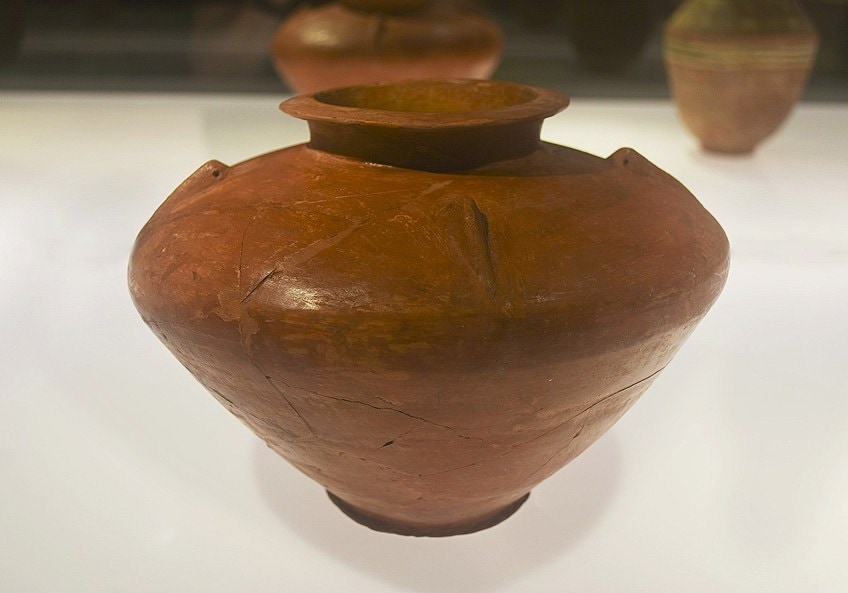 Pottery vessel from the late Susa II period (Uruk Period), 3300-3100 BC, Chogha Mish, Khuzestan Province, Islamic republic of iran;Jerónimo Roure Pérez, CC BY-SA 4.0, via Wikimedia Commons
Pottery vessel from the late Susa II period (Uruk Period), 3300-3100 BC, Chogha Mish, Khuzestan Province, Islamic republic of iran;Jerónimo Roure Pérez, CC BY-SA 4.0, via Wikimedia Commons
The potter'due south bike made it easier to produce pottery. Kilns were too enhanced. Pottery during this flow appeared more than monochrome with lesser decorative motifs on the containers. If in that location were decorations these would appear every bit what is known as "lozenge" motifs. In that location was likewise a large drove of pottery from this period in a range of shapes and sizes suited to different foods and needs. The various jars and vases had large bellies (bodies), shorter necks, and larger openings or mouths.
Neolithic pottery and ceramics in China were functional in nature and had diverse characteristics as the Neolithic period progressed.
During the before Neolithic period, pottery was made from earthenware and fired mostly in bonfires, and these were a blood-red color. Pottery was also hand-made through the coiling method. Jugs were more prominent during the middle Neolithic catamenia in People's republic of china, for example, the amphorae.
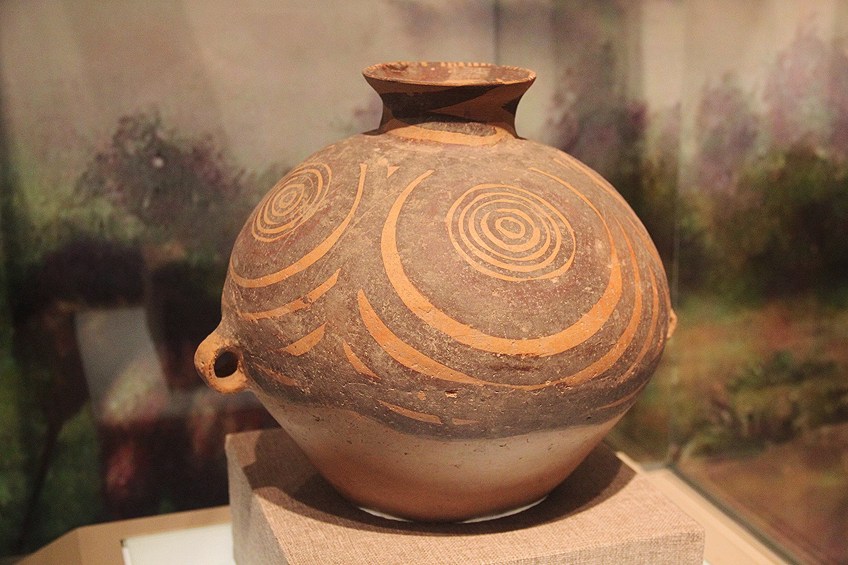 A typical example of Neolithic pottery in China, Xinyang Urban center Museum, Henan Province; Gary Todd, CC0, via Wikimedia Commons
A typical example of Neolithic pottery in China, Xinyang Urban center Museum, Henan Province; Gary Todd, CC0, via Wikimedia Commons
These were also red in color and had various incised patterns. In other regions of China, some pottery was black in color due to it being charcoal-tempered. The later Neolithic periods in People's republic of china were increasingly burnished and decoratively painted with geometric patterns. There were many different Chinese cultures throughout the Neolithic period and the product of pottery and sculpture developed in unique and complex ways.
There were besides various cultural and social factors that allowed this Neolithic art to evolve and go refined not but as a utilitarian object but as a form of craftsmanship.
From the New Stone Age to the Contemporary Age
The Neolithic or New Stone age evolved into the Statuary age, which started with the appearance of more than people using bronze. It started around 3300 BCE and lasted until effectually 1200 BCE. At that place was a wide range of artwork, not to mention extensive bronze carvings, but ceramics also developed more aesthetically. Records of the start type of writing accept been plant from this age too.
 LEFT: Tablet of the Epic of Gilgamish (Obverse side); Stephen Langdon, Public domain, via Wikimedia Commons | RIGHT: Tablet of the Epic of Gilgamish (Opposite side); Stephen Langdon, Public domain, via Wikimedia Commons
LEFT: Tablet of the Epic of Gilgamish (Obverse side); Stephen Langdon, Public domain, via Wikimedia Commons | RIGHT: Tablet of the Epic of Gilgamish (Opposite side); Stephen Langdon, Public domain, via Wikimedia Commons
We will also find the Rock historic period revived in our gimmicky historic period through various artists who replicate the enormity of Neolithic megaliths in everyday objects, for example, artist Mark Leckey's GreenScreenRefrigeratorAction (2010).
Other examples of or "throwbacks" to Neolithic times tin can be viewed in land fine art from the 1970s, for example, Nancy Holt's installations chosen Lord's day Tunnels (1976). These structures, 4 concrete cylinders, were erected in Utah's Neat Basin Desert and marshal with the Summer and Winter Solstice's sunrise and dusk, reminiscent of the astronomical and ceremonial qualities we run into from the Neolithic menstruum fine art.
The Neolithic period was vast and complex, spanning across many regions, consisting of many peoples who all gradually evolved from the hunter-gatherer lifestyle to a more than settled lifestyle including farming and agriculture, and animal domestication. Nosotros can nigh say the Neolithic age fix the stage for how we live today, in communities and settled environments.
Oft Asked Questions
When Was the Neolithic Period?
The Neolithic age occurred, approximately, around 10 000 BCE to 3000 BCE. Information technology was the concluding part of the Stone Historic period, otherwise the "New Stone Age". The word "Neolithic" originates from the Greek words néos meaning "new" and líthos meaning "rock". The Paleolithic historic period preceded the Neolithic historic period.
What Is Neolithic Art?
The Neolithic flow fine art varied in way and subject affair, information technology too occurred in numerous regions worldwide. It consisted of pottery, Neolithic sculpture, statuettes oft of female and male figures, but including animals as well. There were also Neolithic drawings like engravings and wall paintings as well equally rock art on diverse structures, about notably megalithic structures like Stonehenge or Newgrange. Neolithic pictographs were also common and many sources state that these could have been the precursors of writing.
What Are the Characteristics of Neolithic Art?
Neolithic art served different functions, these were either related to food, farming, ritual, ornamentation, or any other purpose related to the Neolithic lifestyle. Neolithic art was not a separate part of Neolithic cultures, the two go together, for instance, the manner people live direct influenced the Neolithic fine art definition and its characteristics. The changes that took place during this time included increased security like personal safety and food. These changes resulted in increased populations, which gave people a sense of place and territory, this also changed the way people treated their environment, for instance, living spaces, tools, objects, and each other.
plascenciahason1966.blogspot.com
Source: https://artincontext.org/neolithic-art/
0 Response to "What Is the Fundamental Stylistic Difference Between Paleolithic Art and Neolithic Art?"
Post a Comment